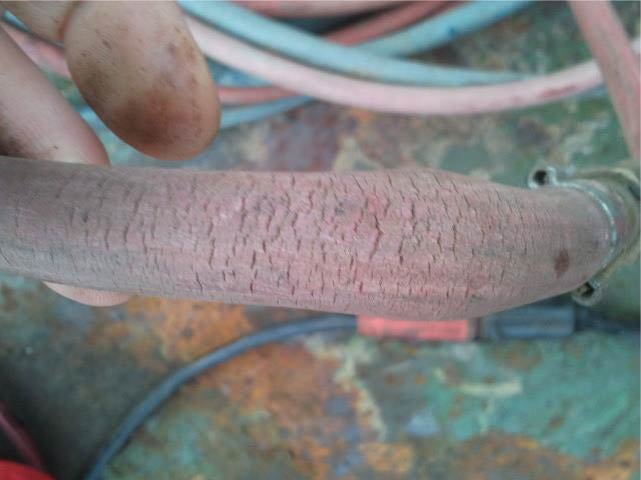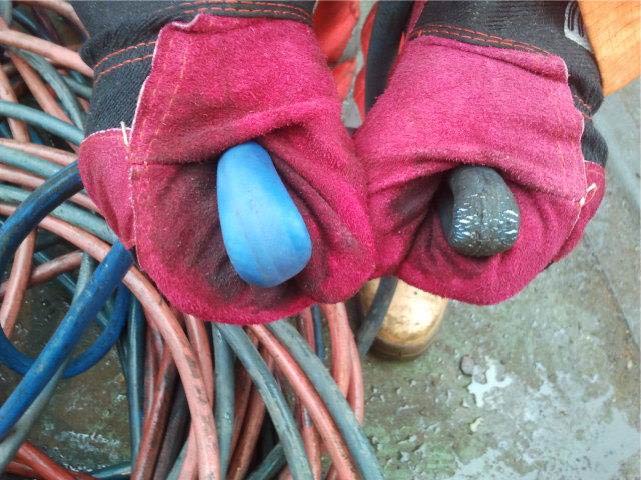Proper care of oxy-acetylene cutting and welding equipment
A member has noted a number of incidents resulting in fires caused by perished hoses and flashbacks involving oxy-acetylene cutting equipment, and has shared the following information with IMCA for use as part of a safety flash.


Flashbacks and backfires
Flashbacks are commonly caused by a reverse flow of oxygen into the fuel gas hose (or fuel into the oxygen hose), producing an explosive mixture within the hose. The flame can then burn back through the torch, into the hose and may even reach the regulator and the cylinder. Flashbacks can result in damage or destruction of equipment, and could even cause the cylinder to explode.
The following precautions will help to prevent flashbacks:
- Use the correct lighting-up procedure;
- Purge the hoses before lighting the torch to remove any potentially explosive gas mixtures;
- Ensure the cutting torch is fitted with spring-loaded non-return valves;
- Use the correct gas pressures and nozzle size for the job;
- Maintain the equipment in good condition.
These measures will reduce the risk of a flashback but will not completely eliminate it. Non-return valves will not stop a flashback once it has occurred.
Protecting cylinders from flashbacks:
- Fit flashback arresters to both the oxygen and fuel gas hoses near to the regulators;
- For long lengths of hose, fit arresters on both the torch and the regulator;
- The fitting of a flashback arrester is not a substitute for safe working practice. If a flashback has occurred, carefully check for damage to the torch, hoses, regulators, flashback arresters and other components. Replace parts if needed.
Equipment checks
- Use a proprietary leak detecting spray or solution suitable for use with oxy/fuel systems. Do not use soapy water or solutions containing grease or oils on oxygen systems;
- Repair or replace leaking components immediately;
- Remove damaged or leaking sections of hose, do not attempt to repair;
- Refit hose tails using crimp clips designed for that task;
- Do not use screw tightened crimps (jubilee clips). Their use may increase the risk of leaks due to the potential for over/under-tightening;
- Inspect all sub-contractor or third-party welding and cutting equipment before use, to ensure:
- hoses are not perished or leaking
- flashback arresters are fitted at both the gauge and torch ends
- correct hose crimps are used at all fittings
- equipment is leak tested
- gauges are serviceable
- all fittings are free from oil and grease contaminants
- ensure thread tape is not used on any connections
- a cylinder key is in place on acetylene cylinders
- cylinders are securely stored upright in a ventilated space
- bulk gas storage is properly separated.
Members may wish to refer to the following incidents (search word: acetylene)
Safety Event
Published: 10 August 2016
Download: IMCA SF 21/16
IMCA Safety Flashes
Submit a Report
IMCA Safety Flashes summarise key safety matters and incidents, allowing lessons to be more easily learnt for the benefit of all. The effectiveness of the IMCA Safety Flash system depends on Members sharing information and so avoiding repeat incidents. Please consider adding safetyreports@imca-int.com to your internal distribution list for safety alerts or manually submitting information on incidents you consider may be relevant. All information is anonymised or sanitised, as appropriate.
IMCA’s store terms and conditions (https://www.imca-int.com/legal-notices/terms/) apply to all downloads from IMCA’s website, including this document.
IMCA makes every effort to ensure the accuracy and reliability of the data contained in the documents it publishes, but IMCA shall not be liable for any guidance and/or recommendation and/or statement herein contained. The information contained in this document does not fulfil or replace any individual’s or Member's legal, regulatory or other duties or obligations in respect of their operations. Individuals and Members remain solely responsible for the safe, lawful and proper conduct of their operations.
